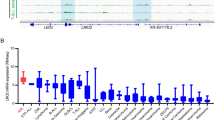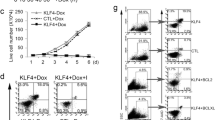Abstract
Special AT-rich sequence-binding protein-1 (SATB1) is critical for genome organizer that reprograms chromatin organization and transcription profiles, and associated with tumor growth and metastasis in several cancer types. Many studies suggest that SATB1 overexpression is an indicator of poor prognosis in various cancers, such as breast cancer, malignant cutaneous melanoma, and liver cancer. However, their expression patterns and function values for adult T cell leukemia (ATL) are still largely unknown. The aim of this study is to examine the levels of SATB1 in ATL and to explore its function and mechanisms in Jurkat cell line. Here, we reported that SATB1 expressions were decreased in ATL cells (p < 0.001) compared with normal controls. Knockdown of SATB1 expression significantly enhanced invasion of Jurkat cell in vitro. Furthermore, knockdown of SATB1 gene enhances β-catenin nuclear accumulation and transcriptional activity and thus may increase the invasiveness of Jurkat cell through the activation of Wnt/β-catenin signaling pathway in vitro.





Similar content being viewed by others
References
Chiaretti S, Gianfelici V, Ceglie G, Foa R. Genomic characterization of acute leukemias. Med Princ Pract. 2014;23(6):487–506.
Soyoral Y, Aslan M, Ebinc S, Dirik Y, Demir C. Life-threatening hypophosphatemia and/or phosphate depletion in a patient with acute lymphoblastic leukemia: a rare case report. Am J Emerg Med 2014. doi: 10.S0735-6757(14)00255-1.
Zeng H, Wang XB, Cui NH, Nam S, Zeng T, Long X. Associations between AT-rich interactive domain 5B gene polymorphisms and risk of childhood acute lymphoblastic leukemia: a meta-analysis. Asian Pac J Cancer Prev. 2014;15(15):6211–7.
Inaba H, Greaves M, Mullighan CG. Acute lymphoblastic leukaemia. Lancet. 2013;381(9881):1943–55.
Sabir N, Iqbal Z, Aleem A, Awan T, Naeem T, Asad S, et al. Prognostically significant fusion oncogenes in Pakistani patients with adult acute lymphoblastic leukemia and their association with disease biology and outcome. Asian Pac J Cancer Prev. 2012;13(7):3349–55.
Huang Y, Zhang L, Song NN, Hu ZL, Chen JY, Ding YQ. Distribution of Satb1 in the central nervous system of adult mice. Neurosci Res. 2011;71(1):12–21.
Richon VM. A new path to the cancer epigenome. Nat Biotechnol. 2008;26(6):655–6.
Yasui D, Miyano M, Cai S, Varga-Weisz P, Kohwi-Shigematsu T. SATB1 targets chromatin remodelling to regulate genes over long distances. Nature. 2002;419(6907):641–5.
Osborne BA. Transcriptional control of T cell development. Curr Opin Immunol. 2000;12(3):301–6.
Burute M, Gottimukkala K, Galande S. Chromatin organizer SATB1 is an important determinant of T-cell differentiation. Immunol Cell Biol. 2012;90(9):852–9.
Agrelo R, Souabni A, Novatchkova M, Haslinger C, Leeb M, Komnenovic V, et al. SATB1 defines the developmental context for gene silencing by Xist in lymphoma and embryonic cells. Dev Cell. 2009;16(4):507–16.
Zhang Y, Tian X, Ji H, Guan X, Xu W, Dong B et al. Expression of SATB1 promotes the growth and metastasis of colorectal cancer. PLoS One. 2014;9(6).
Zhang S, Gao X, Ma Y, Jiang J, Dai Z, Yin X, et al. Expression and significance of SATB1 in the development of breast cancer. Genet Mol Res. 2015;14(2):3309–17.
Liu X, Zheng Y, Qiao C, Qv F, Wang J, Ding B, et al. Expression of SATB1 and HER2 in breast cancer and the correlations with clinicopathologic characteristics. Diagn Pathol. 2015;10:50.
Niu Y, Wang L, Cheng C, Du C, Lu X, Wang G, et al. Increased expressions of SATB1 and S100A4 are associated with poor prognosis in human colorectal carcinoma. APMIS. 2014;123(2):93–101.
Hedner C, Gaber A, Korkocic D, Nodin B, Uhlen M, Kuteeva E, et al. SATB1 is an independent prognostic factor in radically resected upper gastrointestinal tract adenocarcinoma. Virchows Arch. 2014;465(6):649–59.
Chen H, Takahara M, Oba J, Xie L, Chiba T, Takeuchi S, et al. Clinicopathologic and prognostic significance of SATB1 in cutaneous malignant melanoma. J Dermatol Sci. 2011;64(1):39–44.
Zhang L, Cheng F, He R, Chen H, Liu Y, Sun J. Inhibition of SATB1 by shRNA suppresses the proliferation of cutaneous malignant melanoma. Cancer Biother Radiopharm. 2014;29(2):77–82.
Tu W, Luo M, Wang Z, Yan W, Xia Y, Deng H, et al. Upregulation of SATB1 promotes tumor growth and metastasis in liver cancer. Liver Int. 2012;32(7):1064–78.
Zhao XD, Ji WY, Zhang W, He LX, Yang J, Liang HJ, et al. Overexpression of SATB1 in laryngeal squamous cell carcinoma. ORL J Otorhinolaryngol Relat Spec. 2010;72(1):1–5.
Xiang J, Zhou L, Li S, Xi X, Zhang J, Wang Y, et al. AT-rich sequence binding protein 1: contribution to tumor progression and metastasis of human ovarian carcinoma. Oncol Lett. 2012;3(4):865–70.
Nodin B, Hedner C, Uhlen M, Jirstrom K. Expression of the global regulator SATB1 is an independent factor of poor prognosis in high grade epithelial ovarian cancer. J Ovarian Res. 2012;5(1):24.
Selinger CI, Cooper WA, Al-Sohaily S, Mladenova DN, Pangon L, Kennedy CW, et al. Loss of special AT-rich binding protein 1 expression is a marker of poor survival in lung cancer. J Thorac Oncol. 2011;6(7):1179–89.
Wang Y, Su M, Zhou LL, Tu P, Zhang X, Jiang X, et al. Deficiency of SATB1 expression in Sezary cells causes apoptosis resistance by regulating FasL/CD95L transcription. Blood. 2011;117(14):3826–35.
Ahlfors H, Limaye A, Elo LL, Tuomela S, Burute M, Gottimukkala KV, et al. SATB1 dictates expression of multiple genes including IL-5 involved in human T helper cell differentiation. Blood. 2010;116(9):1443–53.
Notani D, Gottimukkala KP, Jayani RS, Limaye AS, Damle MV, Mehta S et al. Global regulator SATB1 recruits beta-catenin and regulates T(H)2 differentiation in Wnt-dependent manner. PLoS Biol. 2010;8(1).
Niu Z, Liu H, Zhou M, Wang H, Liu Y, Li X, et al. Knockdown of c-Myc inhibits cell proliferation by negatively regulating the Cdk/Rb/E2F pathway in nasopharyngeal carcinoma cells. Acta Biochim Biophys Sin (Shanghai). 2015;47(3):183–91.
Liu Z, He Q, Ding X, Zhao T, Zhao L, Wang A. SOD2 is a C-myc target gene that promotes the migration and invasion of tongue squamous cell carcinoma involving cancer stem-like cells. Int J Biochem Cell Biol. 2015;60:139–46.
Choi YL, Tsukasaki K, O’Neill MC, Yamada Y, Onimaru Y, Matsumoto K, et al. A genomic analysis of adult T-cell leukemia. Oncogene. 2007;26(8):1245–55.
Acknowledgments
This study was supported by grants from the National Natural Science Foundation of China (81200399), Key Clinical Disciplines of Guangdong Province (20111219), Guangdong Province Natural Science Foundation (2015A030310126), and Guangzhou Medical and Health Technology Program (20151A011068).
Author information
Authors and Affiliations
Corresponding authors
Ethics declarations
Conflicts of interest
None.
Additional information
Xiao-Dan Luo and Shao-Jiang Yang contributed equally to this work.
Rights and permissions
About this article
Cite this article
Luo, XD., Yang, SJ., Wang, JN. et al. Downregulation of SATB1 increases the invasiveness of Jurkat cell via activation of the WNT/β-catenin signaling pathway in vitro. Tumor Biol. 37, 7413–7419 (2016). https://doi.org/10.1007/s13277-015-4638-x
Received:
Accepted:
Published:
Issue Date:
DOI: https://doi.org/10.1007/s13277-015-4638-x




